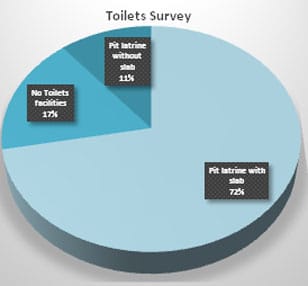A Group of volunteers, lead by Theo and Naomy conducted a community survey from 8th July to 17th July to find the hygiene and sanitation status of temporary shelters in jitpur. The survey was done in 100 shelters. It is found that 50% of shelters have unsatisfactory conditions, 24 % satisfactory and rest of the shelters have moderately satisfactory conditions. Shelters condition indicates leakage from roof, enough space and well managed. Regarding toilet facilities, 83 shelters have access to toilets. Out of 83, 40% have moderate satisfactory conditions, 36% have satisfactory conditions and 24% have unsatisfactory conditions. Toilet facilities condition indicates access to toilets, toilet house and type of toilet facility. It was also checked for cleanliness of toilets (dirty, flies etc.), 52% have moderately satisfied conditions, 26% have unsatisfactory and 22% have satisfactory. People have good access to water, 68% have moderately satisfactory conditions of availability of water, 25% have satisfactory and only 7% have unsatisfactory. It was looked for shelter surroundings for trashes and cleanliness. It is found 46 % have moderately satisfactory shelter surroundings, 36% have satisfactory and 8% have unsatisfactory conditions.

Jitpur is a VIN’s project site where it has supported more than 200 temporary shelters. It was important to know the hygiene and sanitation status of the shelters as monsoon was arriving soon and people were at risk of getting outbreaks of diarrheal diseases. The study was conducted to evaluate the post-earthquake sanitation situation in the community. It was to observe the place where household members usually washed their hands. They looked for regularity of water supply and observed whether households had cleansing agents near the place of hand washing and to promote increased investments in the sector. It was to focus attention on needy areas and efficiently allot resources. Families would receive the materials needed to have hygienic behavior. The hygiene would be a key and complementary component of water and sanitation, and shelter. Promoters would be trained and ready to respond to cholera outbreaks during the monsoon season. As sanitation facilities are put in place, the hygiene promoters would encourage people to use toilet facilities. The people were interviewed with semi structured questionnaire and there was a checklist to observe the conditions.
In details, It s found that 17% of the interviewed households have no toilet facilities. 52% of them have damaged toilet facilities and 70% have temporary toilets. 89% of the interviewed households do not have a direct access to a water source in their toilet facilities, knowing that the closeness of the water source varies from household to another. 94% wash their hands twice or more a day and 88% do it with soap. However, only 25% wash their toilet facilities daily and 70% do it only with water. It can be the cause of several sicknesses such as skin and diarrheal diseases. 47% of the interviewed households declared being never sick and 23% declared being sick every day. The main symptom is the headache with 37%, 23% of them have common colds, 20% of them suffered from stomach pain, 20% of them have diarrhea problems, 19% of them have fever. Those symptoms can be associated with insufficient sanitary practices and non-filtered water. 48% of the children of the interviewed households use the toilet facilities to defecate.
Based on the findings it is concluded that overall hygiene and sanitation status in the shelters is not fully satisfactory. They need support to have a safe place for living, toilet facilities and stuffs for hygiene and sanitation practices. Moreover they should be trained on hygiene and sanitation practices


